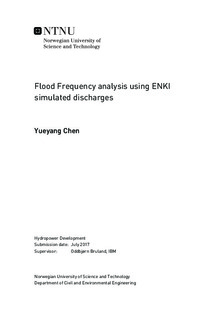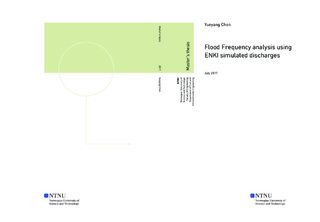| dc.description.abstract | As climate change topics get heated and more related researches have been undertaken, the facts have been observed and revealed that more and more natural disasters and extremelitie are influencing people s way of life dramatically, for instance the flood.
Floods have always been problems in most countries in the world, this paper firstly gives a glance of the methodologies applied in Norway and China traditionally and modernly in dimensioning floods. A comparison of the traditional methods and modern one (rainfall-runoff model) have been carried out.
A case in Guala Catchment along Goula River which brings the most catastrophic floods in Norway historically has been studied. Literature review gives some ideas on how this river behaves and actually inside this catchment, most of the area are protected, to be specific along some parts of the river, there are some drinking water conservations or natural conservations have been protected, which makes the river less regulated compared to most of the Norwegian rivers for power production. This might be one of the reasons discussed in the paper regarding possible reasons of the catastrophic floods formation.
A distributed hydrological model is set up and implemented for the catchment in order to simulate runoff generation where four discharge gauging stations exist. Daily resolution data has been collected on precipitation, air temperature, runoff, relative humidity, wind speed and global radiation so that the ENKI framework containing different sub-routines (models) can be operated. Setup, calibration and validation have been finished by ENKI and a set of best-performed parameters are obtained and listed in the paper. The criteria based on Nash Sutcliffe model efficiency R2 is used to terminate the calibration process, Nash Sutcliffe model efficiency is testified and widely used, but this is not the only criteria to use, since the purpose of the work is to analyze flood, and based on the fact that the annual peak value (AMS) for each year would be picked to proceed with the frequency analysis, the performance of the model in catching the peaks is more important and meaningful than the overall performance in this sense. In addition, manual calibration is taken as well to hit the peaks, finally is it found that PcorrRain, PcorrSnow, TX, k2, k1, k0 have strong correlations with the flood generation. R2 of 0.6 have obtained and compared in calibration period. R2 of 0.42 have been obtained in the validation period.
It seems that there are still big improvements in model calibration due to the time limitation, since the data which has been fixed manually and the ones interpolated by the model must be different, and for such distributed model, data is of crucial importance. So this can be further tested to check which one behaves better. This has been discussed in the conclusion part.
Tradition method Gumbel Distribution in dimensioning flood has been applied in the analysis both to the whole catchment and also two upstream part of the catchment with different sizes. The comparison between the analysis of observed runoff series and simulated runoff series is carried out.
As for the recent frequent floods happened in Gaula Catchments, one potential topic can also be the relationship between climate change, human activities and floods in such a catchment with an area of 3000 km2. | |

